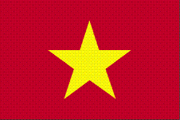
Soviet Federation Flag
Founded in 2995 as Border Countries, the SovECON was a common market on Kebir Blue which was affiliated with the Soviet Federation. Most members of the federation were also in the common market, with the notable exception of the entire Azurni Empire, Staraya, and Snow. The size of the common market was at times nearly thirty members, but started with only four members in 2995. Over the course of time the minimum percentage of dedicated production varied from 15 to 35 per cent in order to accomodate transition.
Early History[]
SovECON was founded 2995 by Milo of the former IND Commonwealth. He ran the organisation until the dissolution of his state in 3021. The leadership position was passed onto the USSR by Ms. Emily (as chairperson) until 3027 when it came until the jurisdiction of the newly formed Finance Bureau. It remained under the supervision of Ringo for nearly 50 years before a series of others took the post. The membership grew very slowly as many of the members of the common market had been Soviet Federation members for some time before joining the organisation. Transition for some countries, in particular Mirabel Soviet Republic, the Soviet Republic of Westam, and People's Republic of Rezalan was difficult, causing some short-term economic damage.
Reform and Regulation, 3127[]
After being elected to the post of chair in 3126, the People's Republic of Rezalan formed a new economic policy jointly with Westam and Kinsek. The document was approved unanimously by the Soviet membership. The text of the policy, formally titled the Soviet Federation Regulatory Finance System (or SFRFS), is below. This was part of a speech delivered in Orwell, in the Democratic Republic of Plato in the winter of 3127.
"The following economic policy should define our federation and common market for the foreseeable future. Its title, the Soviet Federation Regulatory Finance System (SFRFS), refers to a comprehensive system of reform and regulation designed to make economies more robust, leading ultimately to stronger, more independent states. Details of the plan are quite basic but are integral to our survival as a federation".
"The primary economic rule of our federation is that military spending should only occur when it can be afforded on a long-term basis, meaning that an index of 100 per cent (breaking even) is required to maintain armed forces at that particular level. Countries which have finance indeces of 90 and below should work in conjunction with the SovEMC and Finance Executive to streamline their militaries."
"Beyond this instrumental rule, no other index should be made to go over 110 (health, infrastructure, education) unless the finance index is 100 or more. From an infrastructural perspective, there is no benefit to having any index above 100 except finance. Once the economy is routinely yeilding results, small, planned increases to infrastructure can occur. However, the overall index of anything composed of more than one part is always equal to the lowest. The best example of this is that the eduction has three components, so these values should all be made to be equal that way you are being efficient with your spending. Math is always easy as the index is simply a percentage."
"Regarding corps: any business that is losing money consistently MUST be closed. Always diversify your portfolio - don't build 7 oil factories, build different products that are in demand (numbers in red). Attempt to find enterprise/private corporations for your country. It is imperative that you keep your tax rate below 22 per cent. Keep employment levels high as well, preferably above 90 per cent if possible, though with smaller states this is difficult to achieve. Lastly, make sure to bump up your salaries in your corporations (about 180 per cent or so)."
"Ultimately, the success of the Soviet Federation is reliant on the smart economic decisions made by its member states. United in knowledge we are strong. NOT ONE STEP BACK".
Economic Reliability, 3137-3550[]
The Constitution of the Soviet Federation, adopted in 3137, restructured government departmens. As such, effective in 3137, the SovECON fell under the jurisdiction of Federation-Minisitry of Finance. The SovECON did not havr any official leaders at it was jointly managed by the entire department (and in fact government).
Members of the SovECON were, nonetheless, continually reminded of the SFRFS and the economic community generally fared well. Some members of the Soviet Federation remained outside the SovECON, and many SovECON members were not members of the Soviet Federation.
Two severe economic crises occurred during the four centuries of stability. Both were mitigated by the federal government in order to avoid catastrophe. Nonetheless periodic damage to individual states and to the federation as a whole occurred.
Collapse[]
In the 3540s the SovECON was dismantled by the Common Market Merger Treaty. This legislation, negotiated by the CDU and supported by the federation as a whole, was passed by council and by a referendum. Following the legal issue the implementation started. Federal members started the transition in 3545 and over the next three years memebrs left the system. The SovECON officially ended in 3550.
Leaders of the Common Market[]
IND Commonwealth (2995 - 3021) 26 years
USSR (3021 - 3027) 6 years
Soviet Empire of the Leaf (3027 - 3070) 43 years
Soviet Socialist Chiawa (3070 - 3078) 8 years
People's Republic of Rezalan (3078 - 3095) 17 years
Fuso Soviet Empire (3095 - 3120) 25 years
Communist State of Kinsek (3120 -3137) 17 years
